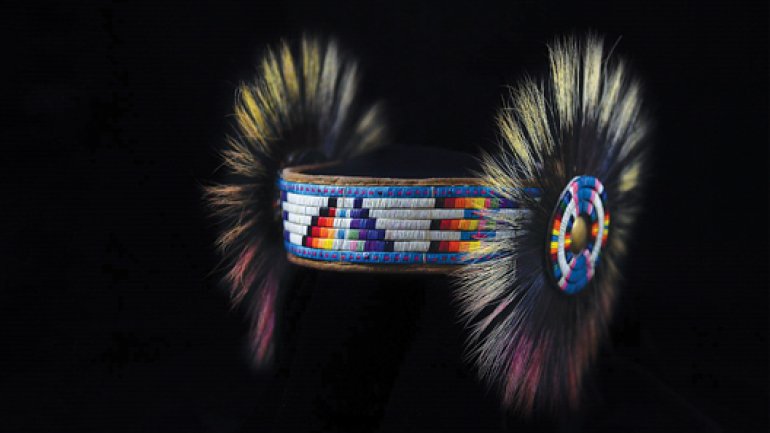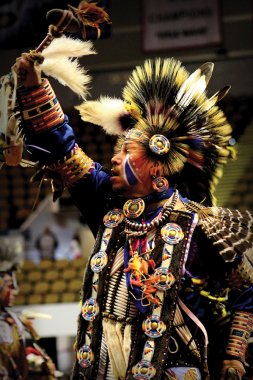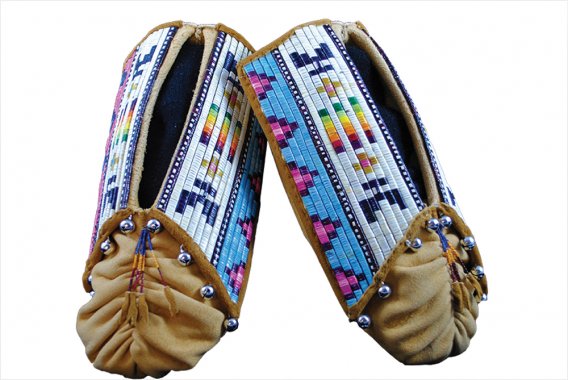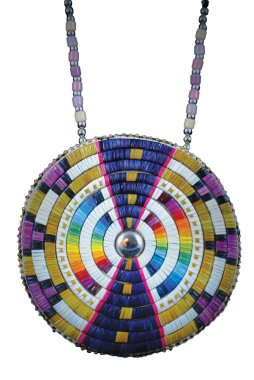Slow Art
Slow Art
Quillwork is a rare, time-consuming practice that requires patience, persistence, and incredible skill. The needle-sized quills first must be removed from the animal, then cleaned, dyed, separated, softened, and flattened before each is individually woven into a fabric or leather backing. Each quill varies in thickness, texture, length, and color.
Dana Warrington, however, is more than up to the task.
The artist, 39, has only been working with quills since 2011, but he’s already making a living from his work. A member of the Prairie Band Potawatomi and Menominee nations, he lives in Cherokee, North Carolina, with his wife and their two daughters, 13 and 11.
Like many Native craftspeople, Warrington’s move into artistry began in the powwow dance arena. He grew up on the Menominee reservation in northern Wisconsin, and, “like most ‘rez’ kids, I started [dancing] when I could walk,” he says. The artist has long admired the majestic imagery of people in their finest regalia dancing among the spirits of their ancestors: “Powwow regalia is 100 percent wearable art.” While many of the dancers craft their own regalia, “I guarantee you that 99 percent of [them] don’t look at themselves as artists,” he says. “The talent in Indian Country is phenomenal.”
Warrington began beading as a teenager, largely out of necessity. If he wanted to dance, he needed a worthy outfit. And if he wanted his regalia ready in a timely fashion, he realized he would have to bead it himself. It was familiar territory for him, since his mom and grandmother also beaded. “We’re around it, and we see it,” he says of his community’s artistic culture.
But the raw, natural beauty of the quills captivated him, and soon he was no longer satisfied wearing beaded dance regalia like most other dancers; he wanted to stand out. “With my quillwork, it was a desire to be different,” he says.
He completed his first quilled earrings and scarf tie in 2012. From there, he was quickly driven to do more. He decided to sell some of his quilled earrings at a powwow to defray the cost of materials. To his surprise, he sold a box of them in less than 15 minutes, suggesting a large demand for quillwork.
Warrington’s success has taken him away from the competitive dance arena, a trade-off he’s learned to live with. “I don’t regret it,” he says, “but I miss it like crazy.” These days he can spend more than 250 hours creating a single piece of quilled art such as a cradleboard (to carry infants), which can sell for $10,000.
The art world is starting to notice. He won Best of Show at the 2017 Eiteljorg Indian Market & Festival and several prizes at the Santa Fe Indian Market.
Warrington doesn’t plan to rest on his laurels. He believes he’ll live to be at least 80, which gives him the next 40 years to work with mentors and grow creatively. Ready for a challenge, he’s already begun mixing quills with silver work. “Somehow, my dream just got bigger,” he says.





